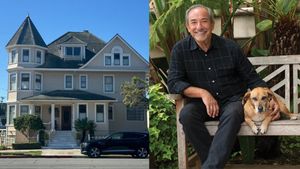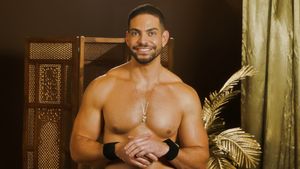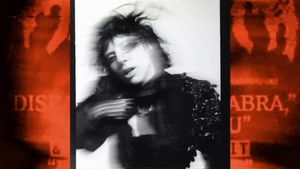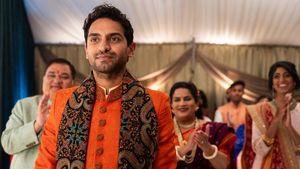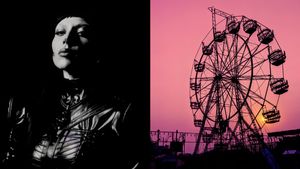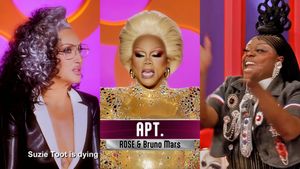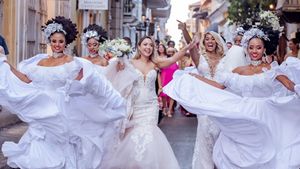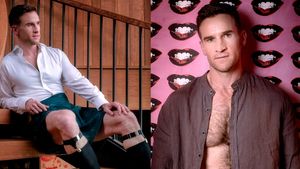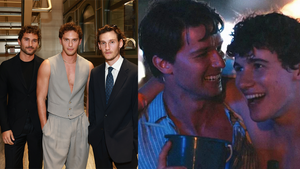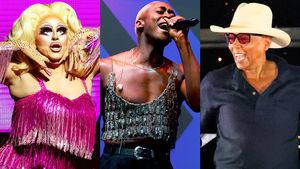The new web series Her Story follows the dating lives of queer and trans women in a way that’s rarely (if ever) shown on screen. Last week, SheWired talked with co-writer, co-producer, and star of Her Story, Jen Richards, about the show, but we also had the privilege of chatting with executive producer Katherine Fisher. Fisher is no stranger to combining art and activism, as a former special events director with Eve Ensler’s V-Day. See what she has to say about the groundbreaking new web series below.
SheWired: What drew you to being a producer?
Katherine Fisher: My background the last few years is more in live event production. I was the head of events for Eve Ensler and the V-Day organization for about ten years. But what drew me to production in general is just the ability to create art. A producer is with a project from its inception until it’s out there in the world, and I like all of those phases.
I was drawn to this idea that we could be activists through art, which is what led me to V-Day. Then, I left V-Day in April, and wanted to start doing more film, and Her Story was the most logical next step. We have an ability, with film especially, to blend that art and activism in a way that’s very universal and can be seen on a much larger platform than something live.
I work with the writers, create the team, find the right director, find the right cinematographer, find the right crew, get the casting done, and put together exactly the right people to create a very specific project. Then, I work with the writers and director to craft the story, and make sure we have a good shooting script. On set, my job is basically to ensure that everything goes smoothly, so I think about what we need to do to get ready for tomorrow, and I make sure that everybody is happy. In post-production, it’s about crafting the post-production team, and working with the editor and director to make sure we’re getting what we need. Then, there’s setting it up for the final stage, which is publicity, trying to get it out there, coming up with a strategy to make sure we get to our target audience, but then also open it up to people who might not have heard of it. So…it’s…it’s involved (laughs).
As far as creating that ideal team goes, Her Story is a little atypical in that the cast and crew is about 80 percent women and/or LGBT folks. What was the process of getting everybody together like, and how do you think that influenced the show?
Well, from the beginning we really wanted to do two things. We wanted to be able to offer it for free—that was really important to us—so that our communities, regardless of where they were, or how much money they had, or how old they were, could see it.
The other thing was getting a cast and crew together that represented the community that we were showing on screen. And that was sometimes tricky, to be honest. At the same time there are so many incredible female and LGBTQ+ identified professionals in this industry. They’re out there; you just have to find them. So, for casting we went with this really great casting director, Geralyn Flood, and for crew we just used our own networks. We talked to our people. We just looked at people’s work, and went after them. Obviously this was very low budget. We had really no money. And on one hand, you really want to pay your community, but on the other hand, you only have so many resources. So what was really interesting was to see how people reacted to the script and whether or not they wanted to be a part of this. And they did. People really gave it their all for not a lot of money. They really put their hearts into it. And that’s, I think, a direct response to the content being representative of the communities that we’re all a part of.
Did everyone on set see this as being as much about activism as art?
I think the majority did. The reason why people were willing to take pay cuts, willing to work long hours, were willing to now, months later, help us get it out there, was because there is that kind of level of activism. People sometimes forget that film and filmmaking is really a kind of art, and a lot of artists don’t go into it thinking they’ll get rich. They go into it for a lot of personal reasons, and I think activism is one of those reasons. So I definitely think it was a motivating factor for a lot of people to be able to work on a set in a safe environment with people in their community, without being afraid of being misgendered, and being able to talk about their relationships, all in the context of creating a story that we all believed would further LGBT representation.
But I can only speak for myself really. It offered me the opportunity to continue to blend art and activism in this format and in this medium, and hopefully on a larger scale than what I’ve been able to do in the past.
Speaking of working on a larger scale, have you had any interest from networks about picking up Her Story?
Yeah, we’ve taken a few meetings. We’re definitely still in the stage where we’re trying to get it out there. Right now our main goal is to prove that the audience is there for this kind of content, so our main focus right now is working to really get the word out and make sure the views go up. We’re just kind of exploring what the best fit is for the content that we have. So we’re still in that process, and we’re still very much open to discussing it with networks and platforms.
This is your first project through your production company, Speed of Joy Productions. How does this compare in scope with what you’ve worked on in the past?
(Laughs) Um…well it’s completely different. My experience in the past has been creating art in service to or under the guidance of other companies or organizations. Which has been incredible. I’ve been extremely fortunate to be able to do that for ten years. The difference here was that this was my first production for my production company, and it was in service to the art that I wanted to create with Jen [Richards], with Laura [Zak], with Sydney [Freeland]. So being able to create the atmosphere that I wanted to create, to be able to craft that team, and having the ability to call the shots—it was very freeing, it was very rewarding, and it was also extremely terrifying.
It was just completely different from everything I’ve done in the past. Just the process of making a narrative series, versus my film experience in the past that’s been mostly documentary and music video, was completely different. It was a fourteen-day shoot versus a one-day shoot. It was a year long process versus a two month long process. And [we had] minimal resources. So it’s a night and day situation, and it was definitely a learning experience. I probably did all the things you’re not supposed to do at some point, but at the same time it was definitely one of the most rewarding experiences I’ve had.Fourteen-day shoots definitely become an endurance test.
Yeah, taking care of yourself. That’s one thing that definitely goes out the window. Just like, eating, and sleeping, and taking a shower.
For people who are trying to create their own art, to do something similar to what Her Story has done, do you have any advice on how to balance making a living (and eating, and sleeping, and showering) with that huge undertaking?
I think it comes down to figuring out how you work individually. If you don’t take care of yourself, you become useless pretty quickly. So recognizing that taking care of yourself is part of the job is helpful. Then it kind of comes down to time management. How much time are you spending on raising money? How much time are you spending on producing? And how much time are you spending on trying to make money and pay the rent? It’s, I think, extremely difficult. Especially for anyone who is an overachiever—which I think a lot of artists are—because the first thing to go is obviously the eating and the sleeping and the bathing. For me, what I tried to do (and again, I failed at this often), is just remind myself that if I don’t do those things, everything else will suffer. It will not benefit the project or me if I don’t actually take care of myself. Unfortunately, I haven’t found an actual formula that works perfectly.
When I talked to Jen Richards, she mentioned one of the things she wished more people would notice in Her Story is the friendship between Violet and Paige. Is there anything about the show that you wish people would notice, either in the narrative, or in terms of production?
To Jen’s point, I do think that’s one of the more interesting storylines. I also want people to look at the interactions within the queer community, and between the group of lesbians. Her Story is about queer women as well, and about the LGBTQ+ community as a whole. I feel like there’s a general feeling from people outside of the LGBTQ+ community that people within it are all progressive, that we all think the same way, and that we’re all in it together, and Kumbaya and stuff, when that’s not really the case.
I would love for people to not just see the Lisa character as a villain, or a way to move the story forward, but to see the way that character interacts with the other queer women in the series. Think about why they’re friends with her, and notice the complexities that exist not just between the straight cis community and LGBTQ community, but also within the LGBTQ community as well.
Is there an ideal conversation that could come out of this for cis queer women talking to their friends about the show?
I don’t know if there’s one ideal conversation, but hopefully it will start a conversation. I think if we can get to a point where there is a dialogue that’s more intersectional rather than trying to fit different conversations into different brackets, that would be amazing. I don’t know if we can do that with Her Story, but being able to show some of that intersectionality will hopefully start that dialogue.
The thing that attracted me to this script in the beginning wasn’t that it was about queer women or trans women, or that it had these conversations necessarily. It was just that it was a simple love story that also had all those things. But first and foremost, it’s a love story. The thing that we tried to keep at the forefront from the beginning was just, how can we get people to watch to the end of the show and just be like, “Goddammit, just kiss already! I don’t care who you are. I don’t care what body you have. I just want you two to be together.” Hopefully we’ve done that, because I feel like once you get people to stop thinking about the specifics, and they’re just rooting for two characters and for love, then the conversations that can come from that become more organic.
I think it, again, comes down to how you enter a production, and making sure that the stories you’re telling on camera are told by people that know those stories. It might not seem like the sound person being trans makes a difference to what’s seen on screen, but it really does. Having that person on set, it creates an environment that makes everybody else feel like we’re all a part of this community and this movement to tell our stories. You’re more invested. Everybody’s experiences are heard.
When you have some diversity on set, regardless of what kind of diversity it is, you’re going to get different opinions. You’re going to get different takes on a scene. And even if it’s just a small conversation over lunch, it still makes a difference. Which is why it’s so important, and which is why I don’t actually understand why so many productions don’t try to have diverse crews and casts, because you’re only going to make it better.Anything else you’d like to add?
Just to go back to your earlier question about people out there who are trying to make their art in their own way… I think what we’ve been able to do so far with Her Story is prove that you can get things done with the help of your community. Whether it’s financially, or actually physically in production. But I think the only way we’re going to be able to really change the way we’re represented is if people continue to try to make this art. And it’s hard, and it’s exhausting, but I think it’s worth it.
We’re just a very small piece of that, and a small step toward that, but it won’t mean a lot if other people don’t also do it. I would urge everyone who is trying to make their art, whatever kind of art it is, to just keep doing it, because it’s all part of that bigger conversation.
I remember when I was little I would maybe see one lesbian on screen a year, and I would just hang on to that, and it would just mean the world to me, even if it was an inaccurate representation, which often they were in the 80s and 90s. But if you think about some of the people who don’t have access to what we have access to here in L.A. or in New York, being able to see themselves represented in some way is really validating. It makes us realize we live in a community. It makes us realize there are people out there who care about us.










































































